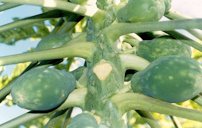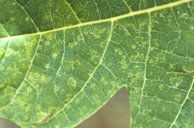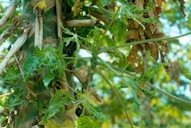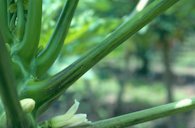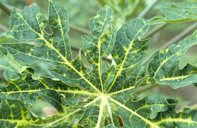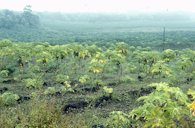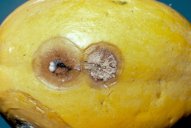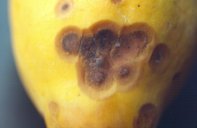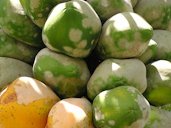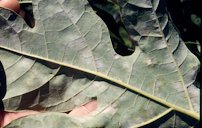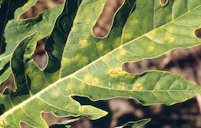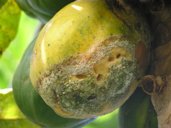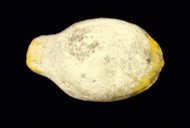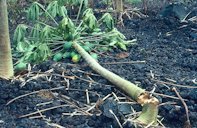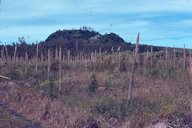| Papaya Diseases | ||||||||||||||||||||||||||||||||||||||||||||||||||||||||
|---|---|---|---|---|---|---|---|---|---|---|---|---|---|---|---|---|---|---|---|---|---|---|---|---|---|---|---|---|---|---|---|---|---|---|---|---|---|---|---|---|---|---|---|---|---|---|---|---|---|---|---|---|---|---|---|---|
| Back
to Papaya Page 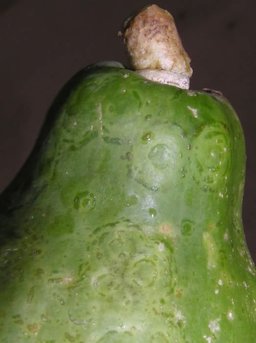
Fig. 1  Papaya ring spot on fruit 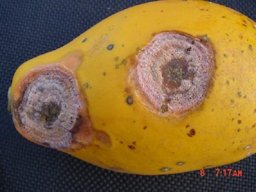 Fig. 12  Sunken lesions with pinkish spore masses on fruits 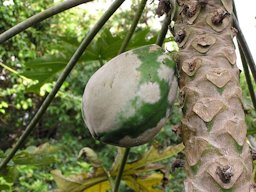 Fig. 17  Powdery mildew on fruit 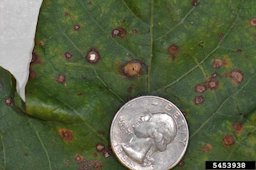 Fig. 24  Corynespora leaf spot 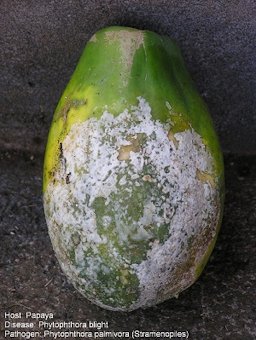 Fig. 25  Phytophthora blight on fruit 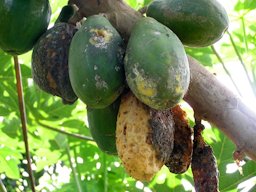 Fig. 26  Phytophthora blight on fruit column 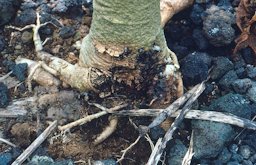 Fig. 27  Phytophthora blight on stem (basal rot) 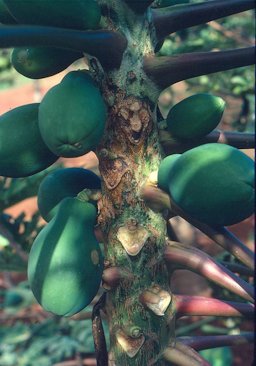 Fig. 32  Phytophthora blight of papaya caused by Phytophthora palmivora: stem rot
|
The principal diseases affecting papaya include papaya ringspot virus,
anthracnose (Colletotrichum gloeosporioides),
powdery mildew (Oidium caricae), leaf spot (Corynespora
cassiicola), and blight (Phytophthora
spp.). Other diseases that intermittently affect papaya production are
papaya droopy necrosis virus and yellow strap leaf (the latter
resulting from a toxin produced by Aspergillus wentii,
which is absorbed from the soil through the roots). 1 Papaya ringspot virus Caused by the Papaya Ringspot Virus (PRSV) (Fig.1) Papaya ringspot is the most important disease of papaya in Florida. The earliest symptoms are a yellow mottling of leaves and vein-clearing of leaves. As the disease progresses, the lobes of the leaves become distorted and leaf size is greatly reduced. Dark green streaks may develop on leaf petioles and the main stem. Fruit symptoms consist of dark circles or C-shaped markings on the fruit peel. Homeowners wishing to grow papaya in their home landscapes should avoid using seed from small, pear-shaped Solo-type fruit, which tend to be more susceptible to this virus than the larger, elongated, oval-shaped fruit found in many local markets. All papaya plants showing symptoms of the virus should be removed so as not to be a source of infection for new plants. Due to the problems with this virus, we recommend replanting papaya plants every 18 to 24 months. 2
Fig. 2. Mottled stem Fig. 3. Mosaic and 'Green Islands' Fig. 4,5. Ringspot on fruit Fig. 6. Foliarmosaic Fig. 7. Shoestring Fig. 8. Streaking on petiole Fig. 9. Vein clearing Fig. 10. Petiole streaking and water soaking Fig. 11. Affected field Anthracnose Caused by Colletotrichum gloeosporioides (Fig.12) The fungus primarily attacks the maturing fruit. Symptoms include small water-soaked spots that enlarge, turn brown or black, and become sunken. Eventually the fungus grows into the fruit tissue, ruining it for consumption. Please contact your local UF/IFAS Extension agent for current control recommendations. 2
Fig. 13,14,15. Sunken lesions with pinkish spore masses on fruits Fig. 16. Complete decay of fruit with spore masses Powdery Mildew Caused by Oidium caricae (Fig.17) This fungus is primarily a disease of the leaves in Florida. A superficial white growth on the leaf surfaces leads to small, light yellow spots on the lower surfaces of the leaves. Next, pale yellow spots appear on the upper leaf surfaces. Eventually, dead leaf areas fall out of the leaves, giving them a shot-hole effect. Control includes removing infested leaves and removing them from near the plants. 2
Leaf Spot Caused by Corynespora cassiicola (Fig. 24) Corynespora leaf spot is a disease of the leaves and begins as small, yellow areas which expand into larger (0.2–0.4 inches) circular brown spots. 2 Phytophthora Blight Caused by Phytophthora palmivora, pseudofungus (Fig. 25,26,27,32) Phytophthora blight (Phytophthora spp.) includes a number of diseases including damping-off, root rot, stem rot, and fruit rot. These diseases decrease plant vigor and may result in plant death. Starting new plants in clean (not previously used) potting media will help avoid the root rots. 2 This fungus is capable of causing damping-off, root rot, stem rot, stem girdling, and fruit rot. Complete loss has been seen in some Miami-Dade fields. Cool, wet environmental conditions with high soil moisture favor disease development. Damping-off occurs in very young plants or in the field shortly after transplanting and is characterized by rapid wilting and plant death. Spots on the stems of established plants begin as water-soaked lesions, especially at fruit and branch scars. These areas can enlarge and girdle the plant, resulting in wilt and death of the plant top. Root infection can be severe and rapid. The first indication of major root infection often is rapid browning and wilting of the plants, followed by total collapse within days. The root infection also has a foul odor. Fruit infection is the most obvious aspect of the disease and potentially very important economically, because of the possibility of carry-over to the market. Water soaked spots are evidence that the fungus is present. Diseased fruit then become covered with a characteristic mass of whitish fungal growth. Fruit eventually shrivel and fall to the ground, where they serve as an important source of inoculum for root rot. 1
Fig. 34. Toppled plant Fig. 33. Incipient stem cankers latex Fig. 34. Phytophthora blight of papaya caused by P. palmivora: basal stem rot and collapse Fig. 35. Destroyed field Further Reading Phytophthora Blight, University of Hawai'i Extension pdf Phytophthora Disease Caused by the Giant African Snail |
|||||||||||||||||||||||||||||||||||||||||||||||||||||||
| Bibliography 1 Mossler, Mark A., and Jonathan Crane. "Florida Crop/Pest Management Profile: Papaya." Horticultural Sciences Department, UF/IFAS Extension, CIR 1402, Original pub. Sept. 2002, Revised Nov. 2009, Reviewed July 2013, Archived, AskIFAS, edis.ifas.ufl.edu. Accessed 18 Feb. 2017, 9 Aug. 2020. 2 Crane, Jonathan."Papaya Growing in the Home Landscape." Horticultural Sciences Department, UF/IFAS Extension, Original pub. Apr. 1994, Revised Oct. 2005, Oct. 2008, Revised Nov. 2016, Reviewed Dec. 2019, AskIFAS, edis.ifas.ufl.edu/054. Accessed 2 Mar. 2017, 12 Apr. 2020. Photographs Fig. 1,2,3,4,5,6,7,8,9,10,11 Nelson, Scot C. "Ringspot (Papaya Ringspot Virus, PRSV)." Hawai'i Plant Disease, (CC BY-SA 2.0), hawaiiplantdisease.net. Accessed 2 Apr. 2014. Fig. 12,13,14,15,16 Nelson, Scot C. "Anthracnose Caused by Colletotrichum gloeosporioides." Hawai'i Plant Disease, (CC BY-SA 2.0), hawaiiplantdisease.net. Accessed 7 Apr. 2014. Fig. 17,18,19,20,21,22,23,25,26,27,28,29,30,31,32,33,34,35 Nelson, Scot C. "Phytophthora blight (Phytophthora palmivora, pseudofungus)." Hawai'i Plant Disease, (CC BY-SA 2.0), hawaiiplantdisease.net. Accessed 8 Apr. 2014. Fig. 24 Brock, Jason. "Corynespora leaf spot on cotton." University of Georgia, 2010, Bugwood.org, (CC BY-NC 3.0 US), bugwood.org. Accessed 7 Apr. 2014. Corynespora leaf spot
Published Feb. 2014 LR. Last update 10 Sept. 2020 LR |
||||||||||||||||||||||||||||||||||||||||||||||||||||||||



